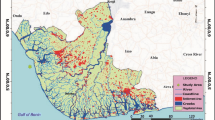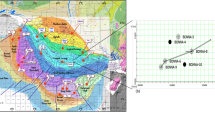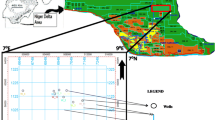Abstract
Channel sand acts as a stratigraphic trap for hydrocarbon accumulation in many parts of the world. Delineation of this type of reservoir is crucial as channel sand may be scarce, and inaccurate location of the drilling wells could lose a huge currency. The Hassi Messaoud (HMD) field was subjected to multiphase tectonic events, where deep-seated structures were rejuvenated leading to intensive fault complexity. The main effective tectonic events upon the studied area are the Hercynian compression and deep erosion till the Ordovician Hamra Quartzite (HQZ) oil reservoir, followed by active Triassic rifting and filling the deeply eroded areas or the graben areas by eruptive volcanic rocks at Triassic time. Hercynian erosion and volcanic rocks distribution introduce a big uncertainty to the reservoir structural model. Amplitude versus offset (AVO) method is used as a helpful tool to differentiate channel sand from surrounding formations. Several attributes (P-impedance, S-impedance, longitudinal velocity Vp, shear velocity Vs and density ρ) are estimated from pre-stack seismic inversion. They have different sensitivity to the reservoir properties. Derived attributes such as Lamé parameters, incompressibility × density (λρ) and rigidity × density (μρ) can provide key lithology and fluid indicators (Goodway et al. 1997, Goodway CSEG Rec 26(6):39-60 2001). Petrophysically relating AVO attributes both to λρ and μρ and to each other in Lambda–Mu–Rho (LMR) cross-plot space can be a good tool for AVO interpretation (Rutherford and Williams Geophysics 54:680–688 1989 and Castagna and Swan Lead Edge 16(4):337–342 1997). After proper data conditioning, simultaneous inversion of pre-stack angle gathers is performed to get acoustic wave impedance (P-impedance), elastic wave impedances (S-impedance) and density ρ, then to calculate λρ and μρ volumes. In the studied area, λρ and μρ are used as a very important key to separate reservoir sands. The λρ and μρ curves are generated at each well location. Cross plots showed a fair separation of sand in the formation, i.e. higher μρ and lower λρ can detect sand. The output λρ and μρ volumes after simultaneous inversion follow the distribution of the sand which is consistent with the wells penetrating the target reservoir. This finding on the extension of the sand reservoir in terms of λρ and μρ. 3D cross-plot zonations are used for lithology discrimination. In this study, well logs were used to constrain lithology and to control the zonation filters by reducing the limits ambiguity. Other types of advanced attributes are calculated and tested. The obtained (μρ–λρ) volume acts as a good indicator for the sand distribution. It was finally used as sand presence index in the area. Also μρ has shown a good linear relationship with porosity. To note that the porosity volume is created based on the linear relationship with μρ. A product of derived porosity and the sand presence index (μρ–λρ) provides a good tool for reservoir characterization and lead to reservoir management, future planning of the field, and setting location for new wells.






















Similar content being viewed by others
References
Acheson DJ (1990) Elementary fluid dynamics, Oxford applied mathematics and computing science series. Oxford University Press, Oxford ISBN 0-19-859679-0
Castagna JP, Swan HW (1997) Principles of AVO crossplotting. Lead Edge 16(4):337–342
Drufuca G, Mazotti A (1995) Ambiguities in AVO inversion of reflections fron a gas-sand. Geophysics 60:134–141
Goodway B (2001) AVO and Lamé constants for rock parameterization and fluid detection. CSEG Recorder 26(6):39–60
Goodway B, Chen T, Downton J (1997) Improved AVO fluid detection and lithology discrimination using Lamé petrophysical parameters; lr, μr and l/μ fluid stack from P and S inversions, CSEG National Convention Expanded Abstracts. 148–151
Ostrander WJ (1984) Plane-wave reflection coefficients for gas sands at non normal angles of incidence. Geophysics 49:1637–1648
Partyka G, Gridley J, Lopez JA (1999) Interpretational applications of spectral decompositions in reservoir characterization. Lead Edge 18:353–260
Rutherford SR, Williams RH (1989) Amplitude-versus-offset variations in gas sands. Geophysics 54:680–688
Walden AT, White RE (1998) Seismic wavelet estimation: a frequency domain solution to a geophysical noisy input-output problem. IEEE Trans Geosci Remote Sens 36:287–297
White RE (1980) Partial coherence matching of synthetic seismograms with seismic traces. Geophys Prospect 28:333–358
Author information
Authors and Affiliations
Corresponding author
Rights and permissions
About this article
Cite this article
Iddir Sadi, M., Yahiaoui, A. & Djeddi, M. Simultaneous inversion application for characterizing Hamra Quartzite tight sand reservoir: a case study from Hassi Messaoud (Algeria). Arab J Geosci 10, 279 (2017). https://doi.org/10.1007/s12517-017-3007-z
Received:
Accepted:
Published:
DOI: https://doi.org/10.1007/s12517-017-3007-z




